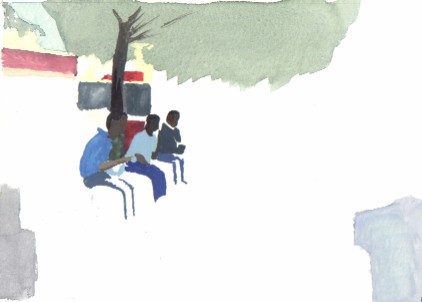|
 |
RSS Feed  |
a playground of art, photos, videos, writing, music, life |
|
|

You are here
|

Creativity!
|

Get it!
|

I like it!
|

Fun stuff!
|

About me...
|
| |
|
|
|
|
Random Quote
Not all writers are artists. But all of us like the idea of somebody in the year 2283 blowing the dust off one of our books, thumbing through it and exclaiming, 'Hey, listen to what this old guy had to say back in the twentieth century!'
-- William Attwood
|
|
|
|
|
|
Blog Posts for "relationships"
Page Through Blog: << More Recent Posts | Home Page
Blog Archive by Month | Blog Archive by Story or Tag | Search Blog and Comments
Blogging Is Not Listening |
You know what a blog is. You're reading one. I'm doing no listening whatsoever as I write this. Listening is inward, and this activity is outward. If I own a company and I want my customer to join in conversation with me, I might write a blog post in the hope that it spurs conversation. The problem is that I'm choosing the topics. That's not a good start for listening to customers. Customer-initiated conversations look more like this: "Hello... ABC Plumbing? This is Mrs. Jones."
"Hi Mrs. Jones. What can I do for you?" Mrs. Jones chooses the topic.A blog is more like this: "Hello... world? This is Bob at ABC Plumbing. I want to talk about..." Look at the customer-initiated topic versus ABC Plumbing's wisdom about faucet care posted on their blog for the whole world to read. Both are important and valuable communication, but one has listening at its heart and the other is, well, marketing.Blogs are necessary and good, but they shouldn't be confused with listening. There are lots of blogs out there that try to spur conversation with customers publicly. And sometimes that happens. But what happens on a blog is not representative of how a business listens to customers. Nor is a survey. Nor is a focus group. Every one of these methods for "listening" has its topics chosen by management. That's not truly listening. What might a survey look like if Mrs. Jones and other current and potential customers chose the topics and questions? What if it were just fill-in-the-blank? What if customers and potential customers chose the some of the topics on a blog site? If conversation happens when both people enter into it with the willingness to be changed by it, then a company needs to use these tools as methods to respond to customers and change the way in which the company conducts business. Show the response. Show the change that the customer initiated. Show that you listened. When you listen, try not to pre-determine the topics of conversation. Otherwise you just might miss the most important thing that you need to hear. |
|
|
How Do You Know If You Matter? |
As a child, we learn that we have importance as we can gain the attention of others. It starts with inarticulate cries - of hunger, for touch, for a diaper change. We cry out to get attention to our needs. If response comes easily, our world is secure. If not, we panic. Fast forward to adulthood. Does this formula change? We all want significance. When you talk, do people listen? Or do you feel like the proverbial tree crashing in the forest? John Gottman, an expert on relationships, writes in his book, The Relationship Cure, of what he calls the "bid." "Let's make sure you understand what I mean when I talk about bids. A bid can be a question, a gesture, a look, a touch - any single expression that says, 'I want to feel connected to you.' A response to a bid is just that - a positive or negative answer to somebody's request for emotional connection." If response comes easily, our world is secure. If not, we hurt. The formula doesn't change. When you bid for connection, and you receive the response of listening, you feel valued and important.By showing that you listen to others, you also tell them that they matter. |
|
|
"That was well-listened." Ever heard someone say that? Me neither. I have heard: "That was well-spoken."
"That was well-written."
"That was well-articulated." We put an emphasis on what goes out - not what goes in - and in a collaborative world, that just might be an oversight.You can easily find training to improve the presentation of your thoughts to others, but it's rare - if not impossible - to find training in receiving others' thoughts. Why is that? Perhaps because there are rewards and recognition for writing and speaking well. You can get a Marconi for radio broadcasting. You can get a Pulitzer for journalism. Toastmasters will celebrate your excellent speech. It's a very good thing to be clear in your communication to others. It's also a very good thing to be able to unwrap and explore the gift of others' thoughts. This is an age of unprecedented partnership and teamwork. Where 1 + 1 can equal 3, or 9, or 27. Listening is the key to working well with others. Listening makes you attractive; you are always welcome when you listen well. At the encouragement of my good friend, Mike Sansone, I will most likely be writing a lot more on this subject. |
|
|
Today I learned that classical music, while perfect for painting, sucks when coding. So I'm here late at night, when no one is around, and I have Marc Cohn in my ears and lemme tell ya - his album with Walking in Memphis on it is pure greatness. My voice is somewhat similar to his, so I'm belting it out. Currently, Dig Down Deep. I love the picture he paints of two people, exploring each other and just talking, late into the night. "Nothing to lose but your sleep." Yes, exactly. His second album didn't have the same appeal for me. And I don't know if he ever had a third, but frankly the first was enough. In a few songs, he describes that very intense, intimate relationship that frightens some people and makes others jealous. Kind of like how Suzanne Vega describes a night with she and her husband when they slept so close together that they woke up with their hair entwined. What a cool metaphor. One life, built with four hands. I think marriage is a wonderful thing. It's beautiful, and difficult, and work and joy... it's supposed to be a lifetime of two peple committed to go nowhere but to work it out and work on it and to mature in their trust of each other. Couples are attacked by problems with money, in-laws who embarrass and in-laws who hate, the togetherness and the separation that comes with children, the tug of career and the needs of home... every day is a new and crazy challenge. So how do you move through it together successfully? Lots of talk, digging deep into each other, and staying true to one life, built with four hands. I miss that. That might be why I like this album so much. The music is great, but the words are genuine and wise and unashamed. He knows of what he sings. Anyway, back to codeville... ETC: I'm shocked and bummed out... I get home to learn that Marc Cohn has been killed wounded in a carjacking attempt. What a loss drag. (Geez... when I first read this story, I thought I read that he had died. But at least he's okay. That's what I get for reading this at 2 AM.) |
|
|
I've noticed something and asked a few women about it, but haven't received any real answers thus far - just shrugged shoulders. If a woman in my office has a great boyfriend or is engaged or newly married, there's a picture of him on her desk. This is true for all three of the women who sit near me who fit this circumstance.  But if I survey the desks of the married women who have children, odds are far better that pictures of their children abound, but dear husband cannot be found. Not one picture. But if I survey the desks of the married women who have children, odds are far better that pictures of their children abound, but dear husband cannot be found. Not one picture.
There are notable exceptions to this, but I can think of only four married women with children in about twenty whose desks exhibit even one picture of their man. Why is that? Some of these women with invisible men seem happily married. One, who sits very near to me, speaks glowingly of her hubby. While her desk has no fewer than four pictures each of her two children, Don's photo is AWOL. Or another woman, who is an amazing conversationalist, has about 10 pictures of her new baby, but none of her husband. And this is, unfortunately, the norm. If I look at the desks of the taken men in the office, there are usually multiple pictures of their girlfriend/fiancee/wife, or at the least a good family photo. I can't think of one who doesn't have a picture of she who matters most to him. So why is this different with women? |
|
|
Yesterday while in the waiting room at the hospital, I was near enough to the reception desk to overhear the not-so-quiet discussion that went on among the five ladies of the office. Each woman, in turn and with no exception, dumped on her husband big time. Each would lampoon her man and grouse about him, and the other women would voice their support and outrage and then contribute a story that agreed with their compatriots. Anyone who knows me knows that I'm very unaccepting of male bad behavior. I'm not an apologist for guys at all, but this 30-minute tirade was just ugly. It ended with one woman fantasizing about leaving her guy, and how she would do it. But she wasn't serious about it, and all that I could think of was the office Christmas party, and how these women would show up with their husbands whom they don't love and carry on as though everything were fine. There's no defense for that kind of gossip and backbiting. |
|
|
Labels restrict function. There's another consultant with whom I work who said to me the other day that he would never accept a permanent position with a company. He likes the people and what he does, but he doesn't want the fetters that come with a job description. He can leap corporate hierarchy and talk to managers up and down the chain about anything that he thinks worth noting. Today, we were struggling with a problem at work that we've had for a while because it occurred to us today that we were constrained by the labels we placed upon the functions. Labels are nice. They quickly convey a complicated idea, but because they are prepackaged, they contain limits. I'm getting a lot from Betty Edwards' book on Color. She talks of the notion of "Color Constancy," which is the idea that an orange should be, well, orange. But if you look at an orange in the light, it's white and yellow and brown in the shadows. Probably other colors too. But Color Constancy limits a painter from succeeding in their work. It makes me think of "People Constancy," which would be the idea that people should fit into convenient buckets formed of our experience. This Constancy thing, it's hard to scrub it from our brains. Betty mentions in the book that one painter in the 1800's would bend over and look at the subject of his painting through his legs, which made it easier for him to see the object as it was and not how he thought it should be. When I paint, I can look at the object and study it hard, but then the minute I turn my attention from it to the paper, my brain takes over and tries to convince me that red onions can't be yellow. In part, I worry about the impression that others might have, like when a child is laughed at for coloring someone's face red or purple. I wonder if that's what prevents people from painting... the impressions of others at their work. I expect that I limit people to certain expected colors... like when my first graphic for "Left-Wingers" was a burning flag. The concept conveyed a concept, all right, but a very limited concept. I find that painting has to be wordless. It's hard, sometimes. I wonder if I'm not wordless enough with how I view others. "Wordless" implies listening, I suppose. No labels. |
|
|
I started the "painting" of the Trafalgar Pigeons today on my lunch break at work. I love the process of painting - it's very scary, but so very educational. Today, I learned this: the only way to really get to know something is to not know it. For example... what color is concrete? Gray, right?  I'm certain that the concrete stub at the right of the picture is the same substance as the pillar on the left. But notice the browns in the pillar and the blue and green in the stub. Or look at the girl's clothes. Do you see the blue in her pink outfit? Or that the pigeon on the box almost merges with the gray wash of the concrete wall? In painting, these are not objects, but splashes of color. I can't paint it if I "know" that concrete is gray. The picture will tell me the truth. My job is to listen and make no assumptions. It's exactly that way in relationships. A husband is smears of hue. A wife is subtle shades of coral and teal. A rainbow, really. We can't know them. If we do, we lose them - because we make assumptions and our innate laziness will forget to probe and explore. And then we don't know them any more. I think it's a tragedy when a couple believes that they can finish one another's sentences. Good, if they're accurate. Nice to be known that way. But horrible if they're wrong. And I think in a lifetime of trying to finish another person's sentence, you lose them because they're no longer defining themselves. Someone else is. Better if we just listen. New colors might pop up. To paraphrase Joanie Mitchell, I guess I really don't know concrete at all. So instead I get to look at it in kid-like wonder. I'll post my progress on this as I go... here's stage 1 - laying down some basic washes and getting oriented.  |
|
|
|
|
|
|
|